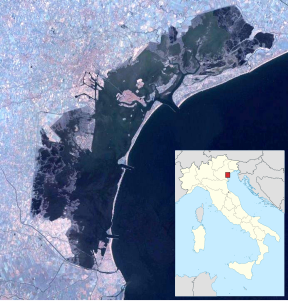San Francesco del Deserto
| San Francesco del Deserto | ||
|---|---|---|
| The island of San Francesco del Deserto | ||
| Waters | Venice lagoon | |
| Geographical location | 45 ° 28 '23 " N , 12 ° 25' 1" E | |
|
|
||
| length | 300 m | |
| width | 170 m | |
| surface | 3,683 2 ha | |
| Highest elevation | 1 m | |
| Residents | 9 (2001) 244 inhabitants / km² |
|
| main place | San Francesco del Deserto (monastery) | |
| Entrance of the monastery | ||
San Francesco del Deserto is a 3.7 hectare island between Burano and Sant'Erasmo in the Venice lagoon . It was inhabited up to around 650 in Roman times, then had to be abandoned in order to be repopulated in the 13th century. The monastery there goes back to a legendary visit by St. Francis of Assisi .
geography
The island is 300 meters long and up to 170 meters wide and up to one meter high. The area covers an area of 3.68 hectares (36,832 square meters). The island had nine residents at the 2001 census, eight of whom were men (monastery).
history
Originally the island was part of a Barena- type landscape . Archaeological traces possibly go back to the 1st century. The island was inhabited in the 4th century and continuously from the 5th century. At that time the island was prospering and so when the sea level rose, they were not ready to give up the island. Therefore, some banks were fortified with parallel rows of palisades. The spaces in between were filled with rubble, fragments of amphorae and bricks. The remains of pottery and parts of a boat that could be dated between 425 and 550 were found 280 cm below the current floor level. During this time, more sediments were deposited and at the same time the sea level rose - a trend that was evident throughout the lagoon. At the end of the 6th century, it was long assumed that the inhabitants had to give up the island despite their best efforts. However, it turned out that the island was inhabited until at least 650. Until then, the island was in a widespread trade in wine and other goods from the entire eastern Mediterranean. Amphora finds also show that goods came from North Africa until the beginning of the 7th century. However, around three quarters of the shards came from the Aegean Sea and Asia Minor.
Called Isole delle due Vigne in the High Middle Ages , legend has it that it was chosen as a residence by the preacher Francis of Assisi, who returned from Egypt and Palestine in 1220, because of its quiet location and the possibility of living here in peace and humility. In March 1233, the island was donated by Jacopo Michiel to the Franciscan order, which had now been established. He belonged to the Doge family and was related through his wife to the Patriarch of Grado, Angelo Barozzi. The order of the Francescani Minori (Minorites) built a monastery where the saint had built his first modest dwelling (in the meantime the island was called San Francesco ) and where one of the two churches already stood . This was given up in 1420 because the climatic conditions had deteriorated so much that it was impossible to remain on the island. The island was uninhabited for over 30 years. The devastation and the emptiness on the island gave it its current name San Francesco del Deserto .
In 1453 the Frati Minori Osservanti received the island from Pope Pius II . The monks renovated the church and the convent, and they built the renaissance monastery. Pope Clement VIII gave the monastery and the island to the Frati Minori Riformati in 1594. They brought cypress trees to the island and renovated the refectory .
In 1797 the Republic of Venice was overturned by Napoleon , French soldiers plundered the island and stole numerous art treasures. In 1806 the monastery, like all monasteries, was closed and the monks left the island. After half a century in which the deserted island served as a powder magazine, the Franciscans returned on December 23, 1856 at the request of the Austrians, who donated the island to the Patriarchate of Venice . On May 31, 1858, the Franciscans returned to the island.
The monastery walls, peeking out between cypresses, contain two cloisters and are visited by tourists who are looking for peace, tranquility and hospitality on San Francesco del Deserto. The island can only be reached by private boat from Burano or Sant'Erasmo.
Remarks
- ↑ Venice Islands ( memento of March 24, 2009 in the Internet Archive ).
- ↑ Istat
- ^ AJ Ammerman, Maurizia de Min, R. Housley, CE McClennen: More on the origins of Venice , in: Antiquity 69/264 (September 1995), pp. 501-510, here: pp. 501-503.



